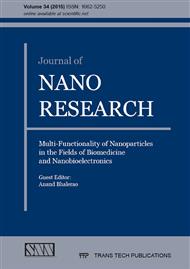[1]
H. Zhang, G. Du, W. Lu, L. Cheng, X. Zhu, Z. Jiao, Porous TiO2 hollow nanospheres: synthesis, characterization and enhanced photocatalytic properties, CrystEngComm. 2 (2012) 3793.
DOI: 10.1039/c2ce06731e
Google Scholar
[2]
H. Zhu, J. Yang, S. Feng, M. Liu, J. Zhang, G. Li, Growth of TiO2 nanosheet-array thin films by quick chemical bath deposition for dye-sensitized solar cells, Appl. Phys. A 105 (2011) 769–774.
DOI: 10.1007/s00339-011-6513-y
Google Scholar
[3]
X. Feng, K. Shankar, O.K. Varghese, M. Paulose, T.J. Latempa, C.A. Grimes, Vertically Aligned Single Crystal TiO2 Nanowire Arrays Grown Directly on Transparent Conducting Oxide Coated Glass: Synthesis Details and Applications, Nano Lett. 8 (2008).
DOI: 10.1021/nl802096a
Google Scholar
[4]
X. Yang, J. Zhuang, X. Li, D. Chen, G. Ouyang, Z. Mao, Y. Han, Z. He, C. Liang, M. Wu, J.C. Yu, Hierarchically Nanostructured Rutile Arrays: Acid Vapor Oxidation Growth and Tunable Morphologies, ASC Nano 3 (2009) 1212.
DOI: 10.1021/nn900084e
Google Scholar
[5]
F. Sauvage, F. D. Fonzo, A. L. Bassi, C.S. Casari, V. Russo, G. Divitini, C. Ducati, C.E. Bottani, P. Comte, M. Graetzel, Hierarchical TiO2 Photoanode for Dye-Sensitized Solar Cells, Nano Lett. 10 (2010) 2562–2567.
DOI: 10.1021/nl101198b
Google Scholar
[6]
K. Kiatkittipong, J. Scott, R. Amal, Hydrothermally synthesized titanate nanostructures: impact of heat treatment on particle characteristics and photocatalytic properties, ACS applied materials & interfaces 3 (2011) 3988.
DOI: 10.1021/am2008568
Google Scholar
[7]
J. Yan, H. Song, S. Yang, X. Chen, Effect of heat treatment on the morphology and electrochemical performance of TiO2 nanotubes as anode materials for lithium-ion batteries, Materials Chemistry and Physics 118 (2009) 367-370.
DOI: 10.1016/j.matchemphys.2009.08.007
Google Scholar
[8]
A. M. Luis, M. C. Neves, M. H. Mendonça, O. C. Monteiro, Influence of calcination parameters on the TiO2 photocatalytic properties, Materials Chemistry and Physics 125 (2011) 20-25.
DOI: 10.1016/j.matchemphys.2010.08.019
Google Scholar
[9]
P. Xiao, D. Liu, B. Garcia, S. Sepehri, Y. Zhang, G. Cao, Electrochemical and photoelectrical properties of titania nanotube arrays annealed in different gases, Sensors and Actuators B: Chemical 134 (2008) 367-372.
DOI: 10.1016/j.snb.2008.05.005
Google Scholar
[10]
A.H. Mayabadi, V.S. Waman, M.M. Kamble, S.S. Ghosh, B.B. Gabhale, S.R. Rondiya, A.V. Rokade, S.S. Khadtare, V.G. Sathe, H.M. Pathan, S.W. Gosavi, S.R. Jadkar, Evolution of structural and optical properties of rutile TiO2 thin films synthesized at room temperature by chemical bath deposition method, J. Phys. Chem. Solids 75 (2014).
DOI: 10.1016/j.jpcs.2013.09.008
Google Scholar
[11]
K. Wessels, M. Minnermann, J. Rathousky, M. Wark, T. Oekermann, Influence of Calcination Temperature on the Photoelectrochemical and Photocatalytic Properties of Porous TiO2 Films Electrodeposited from Ti(IV)-Alkoxide Solution, J. Phys. Chem. C 112 (2008).
DOI: 10.1021/jp803743k
Google Scholar
[12]
J. Yan, S. Feng, H. Lu, J. Wang, J. Zheng, J. Zhao, L. Li, Z. Zhu, Alcohol induced liquid-phase synthesis of rutile titania nanotubes, Mater. Sci. Eng. B 172 (2010) 114–120.
DOI: 10.1016/j.mseb.2010.04.032
Google Scholar
[13]
R. Liu, L. Qiang, W. Yang, H. Liu, The effect of calcination conditions on the morphology, the architecture and the photo-electrical properties of TiO2 nanotube arrays, Mater Res Bull 48 (2013) 1458–1467.
DOI: 10.1016/j.materresbull.2012.12.044
Google Scholar
[14]
H. Chen, W. Fu, H. Yang, P. Sun, Y. Zhang, L. Wang, W. Zhao, X. Zhou, H. Zhaoa, Q. Jing, X. Qia, Y. Li, Photosensitization of TiO2 nanorods with CdS quantum dots for photovoltaic devices, Electrochimica Acta 56 (2010) 919–924.
DOI: 10.1016/j.electacta.2010.10.003
Google Scholar


